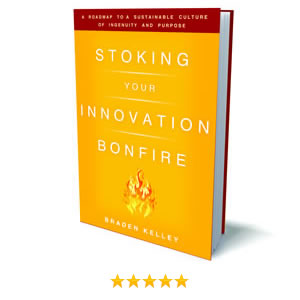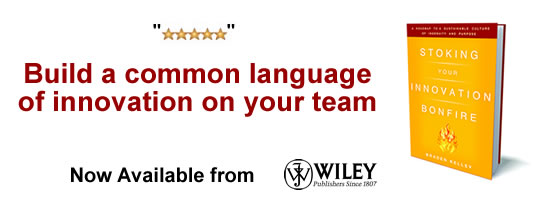 Key Dangers:
Key Dangers:
- Viewing innovation as a temporary, extraordinary effort in response to a crisis, or pursuing innovation as a competitive response.
- Treating innovation as the domain of only the R & D or Marketing department, or some other subgroup.
- Treating innovation as a project-based activity, instead of as an integral organizational capability to be invested in and professionally managed.
Success can be blinding. Organizations often drive themselves by trying to look through the windscreen and in the rearview mirror, only to get blindsided by something from the left or the right. Put another way, organizations often focus on what they’ve already done and moving it forward (often in an incremental way). Organizations also invest in defending and extending the core products and services that made them successful — focusing a huge amount of energy on protecting their flank. Don’t get me wrong, incremental innovation is important, but all of your competitors are trying to make their products and services incrementally better than yours at the same time. At best, your efforts will allow you to maintain or make slight improvements in revenue and profitability.
Success can be blinding. Organizations often drive themselves by trying to look through the windscreen and in the rearview mirror, only to get blindsided by something from the left or the right. Put another way, organizations often focus on what they’ve already done and moving it forward (often in an incremental way). Organizations also invest in defending and extending the core products and services that made them successful — focusing a huge amount of energy on protecting their flank. Don’t get me wrong, incremental innovation is important, but all of your competitors are trying to make their products and services incrementally better than yours at the same time. At best, your efforts will allow you to maintain or make slight improvements in revenue and profitability.
And of course, companies that fail to invest in at least incremental innovation efforts often find themselves getting less and less competitive in the marketplace. Ultimately, the organizations that create sustainable success are those that invest in not only identifying and implementing the change that their customers desire and require, but also the change that is necessary inside the organization to deliver it.
Who Innovates?
Do you have a group of innovation elites in your organization? Maybe these are folks in Marketing or in Research & Development. Or do you make a concerted effort for all of your employees to feel that it is part of their job to innovate? If people feel that innovation is someone else ’ s job, then they ’ re not going to participate, and you are going to miss out on a whole spectrum of interesting innovation ideas. The fact is that markets are too big, too complex, and opportunities for insight lie in too many different reference industries and geographies for any small number of people to be able to successfully sense and ideate. I heard Dr. Alph Bingham, founder of Innocentive, recently talking about who actually solves most of their challenges, and he said that if you were to classify people across a spectrum of those who you believed would be most likely to solve the challenges on the left and those you believed would be least likely to solve the challenges on the right, most of the solutions come from the right-hand side. So if the best solutions are most likely to come from those you would deem least likely, wouldn’t it make sense to include everyone in your organization in your innovation efforts? And possibly people outside your organization?
Innovating in a Crisis
Companies that only have the courage to innovate when there is a crisis, or a competitive response is needed, will be unable to achieve sustainable innovation. Not only that, but their innovation attempts are likely to lack the vision necessary to leap ahead of the crisis or competition — instead they will merely meet the threat and keep the organization as a reactionary pursuer of innovation instead of becoming a leader. This is the GM approach to innovation — constantly trying to catch up to where Toyota was five years ago — instead of trying to jump the next curve and regaining a leadership position. Innovating in crisis often means that the main motivator is going to be fear. Fear does not serve as an effective motivator for innovation. We know because of the inverse correlation between the fear of failure and the quantity and quality of innovation in organizations. Organizations looking to innovate in a crisis cannot do so over and over, and so they must find a way to transform feelings of fear into a believable, committed challenge mentality. To make an analogy: When the Russians launch Sputnik, you have to commit to an innovation moonshot.
Innovation Is Not a Project
Often when companies attempt to innovate because of a crisis or in response to the competition, they pursue innovation as a project. When you pursue innovation as a project, the organization does not build any kind of innovation capability. Instead a group of people come together to tackle a particular challenge, and when the work is complete everyone goes back to their day jobs. None of the learnings are retained in a meaningful and easy-to-access manner for future projects, and there is no opportunity for policies and processes to be refined for greater efficiency next time. You may be pursuing a portfolio of innovation projects, but innovation itself is not a project. Projects start and stop, but for innovation to be sustainable, it must be continuous. This often means investing in a small core team of people (maybe only allocating part of their time) to serve as innovation shepherds — identifying and cataloging innovation best practices and building the innovation capabilities of the organization so that all innovation projects in the portfolio
may benefit.
Excerpted from Stoking Your Innovation Bonfire. You can read ahead by getting the book or downloading the sample chapter, or by checking out parts 2-4 here:
- Making Innovation Sustainable – Part 2 of 4
- Making Innovation Sustainable – Part 3 of 4
- Making Innovation Sustainable – Part 4 of 4
- Managing Innovation is about Managing Change
![]() Sign up here to get Human-Centered Change & Innovation Weekly delivered to your inbox every week.
Sign up here to get Human-Centered Change & Innovation Weekly delivered to your inbox every week.

